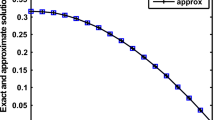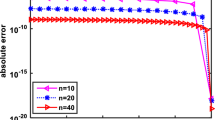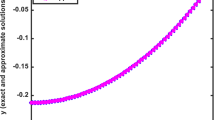Abstract
This paper is concerned with the development of a collocation method based on the Bessel polynomials for numerical solution of a general class of nonlinear singular boundary value problems (SBVPs). Due to the existence of singularity at the point \(x=0,\) we first modify the problem at the singular point. The proposed method is then developed for solving the resulting regular boundary value problem. To demonstrate the effectiveness and accuracy of the method, we apply it on several numerical examples. The numerical results obtained confirm that the present method has an advantage in terms of numerical accuracy over the uniform mesh cubic B-spline collocation (UCS) method (Roul and Goura in Appl Math Comput 341:428–450, 2019), non-standard finite difference (NSFD) method (Verma and Kayenat in J Math Chem 56:1667–1706, 2018), three-point finite difference methods (FDMs) (Pandey and Singh in Int J Comput Math 80:1323–1331, 2003; Pandey and Singh in J Comput Appl Math 205:469–478, 2007) and the cubic B-spline collocation (CBSC) method (Caglar et al. in Chaos Solitons Fractals 39:1232–1237, 2009)









Similar content being viewed by others
References
M. Abukhaled, S.A. Khuri, A. Sayfy, A numerical approach for solving a class of singular boundary value problems arising in physiology. Int. J. Numer. Anal. Model. 8, 353–363 (2010)
H. Caglar, N. Caglar, M. Ozer, B-spline solution of non-linear singular boundary value problems arising in physiology. Chaos Solitons Fractals 39, 1232–1237 (2009)
P.L. Chambre, On the solution of the Poisson-Boltzmann equation with the application to the theory of thermal explosions. J. Chem. Phys. 20, 1795–1797 (1952)
M.M. Chawla, S. Mckee, G. Shaw, Order \(h^{2}\) method for singular two-point boundary value problem. BIT. 26, 318–326 (1986)
H.S. Fogler, Elements of Chemical Reaction Engineering, 2nd edn. (Prentice-Hall Inc, New Jersey, 1992)
B.F. Gray, The distribution of heat sources in the human head: a theoretical consideration. J. Theor. Biol. 82, 473–476 (1980)
H. Madduri, P. Roul, A fast-converging iterative scheme for solving a system of Lane-Emden equations arising in catalytic diffusion reactions. J. Math. Chem. 57, 570–582 (2019)
S.R.K. Iyengar, P. Jain, Spline finite difference methods for singular two point boundary value problems. Numer. Math. 50, 363–376 (1987)
M.K. Kadalbajoo, V. Kumar, B-spline method for a class of singular two-point boundary value problems using optimal grid. Appl. Maths. Comput. 188, 1856–1869 (2007)
J.H. He, F.Y. Ji, Taylor series solution for Lane-Emden equation. J. Math. Chem. 57(8), 1932–1934 (2019)
H.S. Lin, Oxygen diffusion in a spherical cell with nonlinear oxygen uptake kinetics. J. Theor. Biol. 60, 449–457 (1976)
R.K. Pandey, A finite difference methods for a class of singular two point boundary value problems arising in physiology. Int. J. Comput. Math. 65, 131–140 (1997)
R.K. Pandey, On the convergence of a spline method for singular two point boundary value problems arising in physiology. Int. J. Comput. Math. 79, 357–366 (2002)
R.K. Pandey, On a class of regular singular two point boundary value problems. J. Math. Anal. Appl. 208, 388–403 (1997)
R.K. Pandey, On a class of weakly regular singular two-point boundary value problems, II. J. Differ. Equ. 127, 110–123 (1996)
R.K. Pandey, A.K. Singh, On the convergence of finite difference methods for general singular boundary value problems. Int. J. Comput. Math. 80, 1323–1331 (2003)
R.K. Pandey, A.K. Singh, On the convergence of finite difference methods for weakly regular singular boundary value problems. J. Comput. Appl. Math. 205, 469–478 (2007)
P. Roul, A fourth-order non-uniform mesh optimal B-spline collocation method for solving a strongly nonlinear singular boundary value problem describing electrohydrodynamic flow of a fluid. Appl. Numer. Math. 153, 558–574 (2020)
P. Roul, D. Biswal, A new numerical approach for solving a class of singular two point boundary value problems. Numer. Algorithms 75, 531–552 (2017)
P. Roul, Doubly singular boundary value problems with derivative dependent source function: A fast-converging iterative approach. Math. Method Appl. Sci. 42(1), 354–374 (2019)
P. Roul, V.M.K.P. Goura, B-spline collocation methods and their convergence for a class of nonlinear derivative dependent singular boundary value problems. Appl. Math. Comput. 341, 428–450 (2019)
P. Roul, H. Madduri, A new highly accurate domain decomposition optimal homotopy analysis method and its convergence for singular boundary value problems. Math. Method Appl. Sci. 41(16), 6625–6644 (2018)
J. Rashidina, Z. Mahmoodi, M. Ghasemi, Parametric spline method for a class of singular two-point boundary value problems. Appl. Maths. Comput. 188, 58–63 (2007)
A.S.V. Ravikanth, V. Bhattacharya, Cubic spline for a class of nonlinear singular boundary-value problems arising in physiology. Appl. Math. Comput. 174, 768–774 (2006)
A.S.V. Ravikanth, Cubic spline polynomial for non-linear singular two-point boundary value problems. Appl. Math. Comput. 189, 2017–2022 (2007)
A.K. Verma, S. Kayenat, On the convergence of Mickens type nonstandard finite difference schemes on Lane-Emden type equations. J. Math. Chem. 56, 1667–1706 (2018)
P. Roul, U. Warbhe, New approach for solving a class of singular boundary value problem arising in various physical Models. J. Math. Chem. 54(6), 1255–1285 (2016)
A.M. Wazwaz, The variational iteration method for solving nonlinear singular boundary value problems arising in various physical models. Commun. Nonlinear. Sci. Numer. Simulat. 16, 3881–3886 (2011)
J.H. He, Y.O. El-Dib, Homotopy perturbation method for Fangzhu oscillator. J. Math. Chem. 58(10), 2245–2253 (2020)
J.H. He, Y.O. El-Dib, The reducing rank method to solve third-order Duffing equation with the homotopy perturbation. Numer. Methods Part. Differ. Equ. 37(2), 1800–1808 (2020)
J.H. He, Approximate analytical solution for seepage flow with fractional derivative with porous media. Comput. Methods Appl. Mech. Eng. 167, 57–68 (1998)
P. Roul, U. Warbhe, A novel numerical approach and its convergence for numerical solution of nonlinear doubly singular boundary value problems. J. Comput. Appl. Math. 296, 661–676 (2016)
P. Roul, On the numerical solution of singular boundary value problem: a domain decomposition homotopy perturbation approach. Math. Method Appl. Sci. 40(18), 7396–7409 (2017)
P. Roul, U. Warbhe, A new homotopy perturbation scheme for solving singular boundary value problems arising in various physical models. Z. Naturforsch. A. 72(8), 733–743 (2017)
P. Roul, An improved iterative technique for solving nonlinear doubly singular two-point boundary value problems. Eur. Phys. J. Plus 131, 209 (2016)
P. Roul, A new efficient recursive technique for solving singular boundary problem arising in various physical models. Eur. Phys. J. Plus 131, 105 (2016)
J.H. He, X.H. Wu, Variational iteration method: new development and applications. Comput. Math. Appl. 54, 881–894 (2007)
P. Roul, Numerical solutions of time fractional degenerate parabolic equations by variational iteration method with Jumarie modified Reimann-Liouville derivative. Math. Method Appl. Sci. 34, 1025–1035 (2011)
Acknowledgements
This work was supported by the CSIR, India in the form of project no.\(25(0286)/18/EMR-11\).
Author information
Authors and Affiliations
Corresponding author
Additional information
Publisher's Note
Springer Nature remains neutral with regard to jurisdictional claims in published maps and institutional affiliations.
Rights and permissions
About this article
Cite this article
Roul, P., Kumari, T. & Goura, V.M.K.P. An efficient numerical approach for solving a general class of nonlinear singular boundary value problems. J Math Chem 59, 1977–1993 (2021). https://doi.org/10.1007/s10910-021-01279-7
Received:
Accepted:
Published:
Issue Date:
DOI: https://doi.org/10.1007/s10910-021-01279-7




